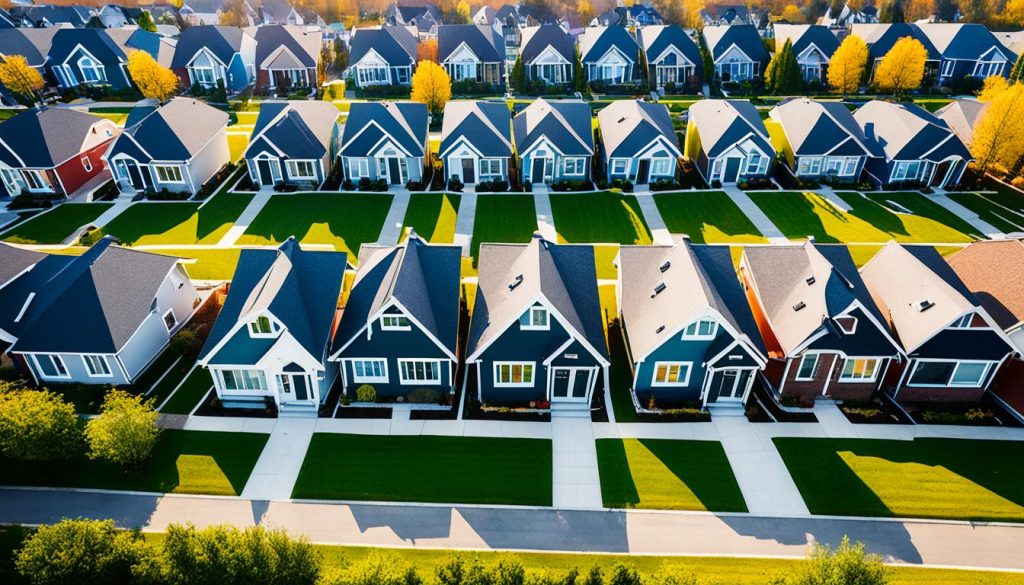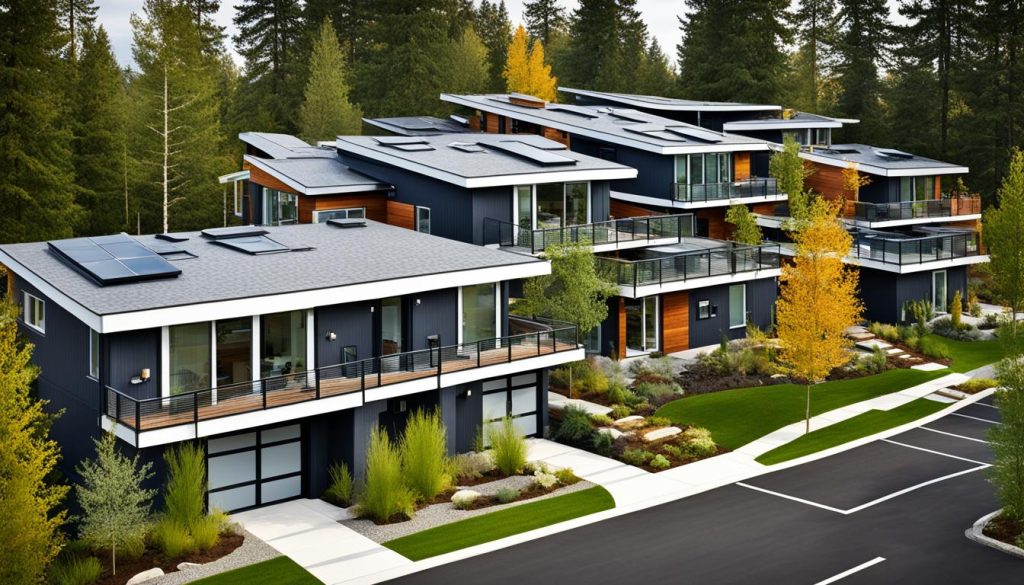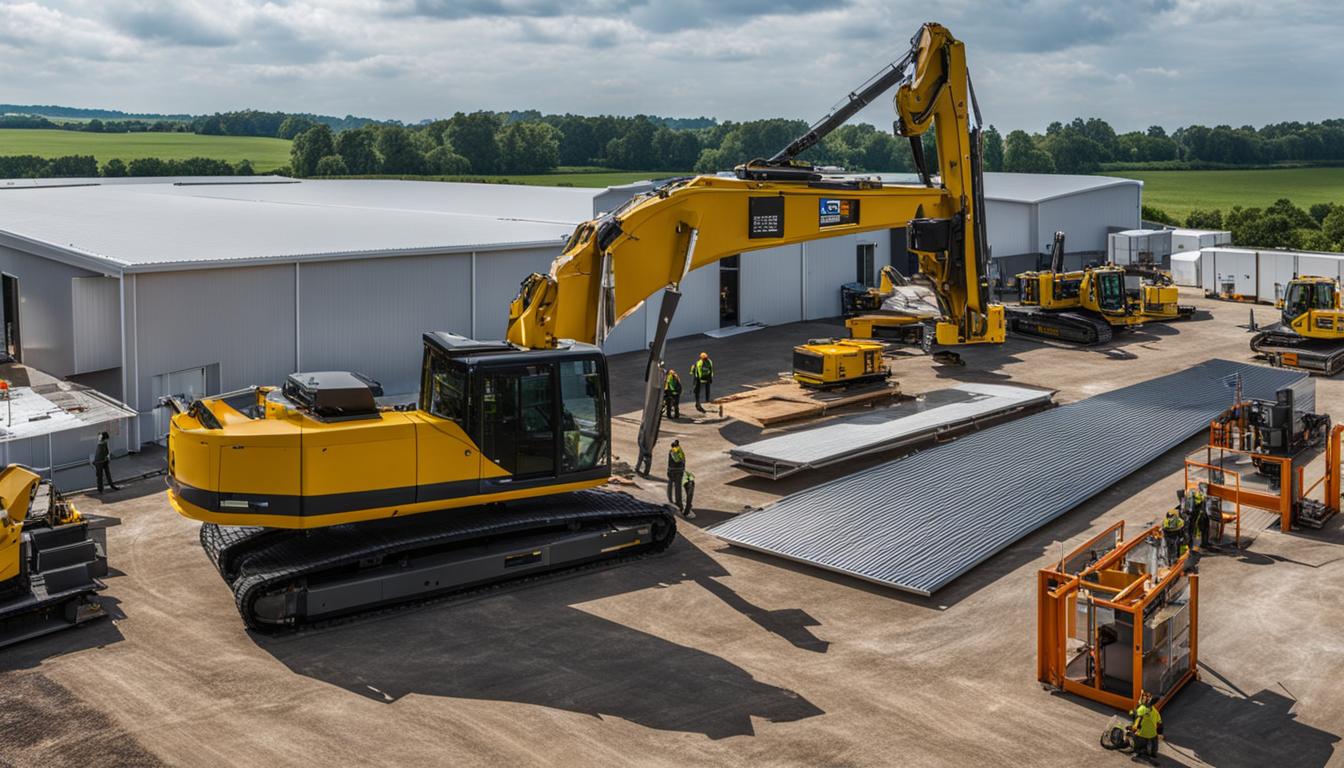Did you know that the concept of modular homes dates back to ancient times? From the construction of the pyramids in ancient Egypt to the rebuilding of Lisbon after an earthquake, modular construction has a rich history that has evolved over time. Today, modular homes offer a fast, cost-effective, and sustainable solution for modern housing needs. Let’s take a closer look at the origins and evolution of modular housing.
Key Takeaways:
- Modular homes have a long history, dating back to ancient times.
- The modern concept of modular homes began in the 19th century.
- Modular construction gained popularity during the California Gold Rush.
- Post-World War II saw a boom in modular construction due to the need for temporary housing.
- Modular construction has continued to evolve and become more efficient and sustainable.
The Origins of Modular Homes
Modular homes have a fascinating history that stretches back to ancient times. The concept of prefabrication and modular construction can be seen in various civilizations throughout history. For instance, one notable example is the Sweet Track Road built in England around 3800 BC. This road was constructed using prefabrication techniques, with sections of the road prefabricated and then assembled on-site. Similarly, the ancient Egyptians utilized modular construction when building their iconic pyramids. Carved blocks were created and transported to the construction site, where they were assembled to form these monumental structures.
In more recent history, the idea of modern modular homes began to take shape. During the Renaissance, the brilliant artist and inventor Leonardo da Vinci designed prefabricated houses for new settlements. Another significant development in modular construction occurred after the devastating Lisbon earthquake in 1755. The city was rebuilt using large-scale prefabrication techniques, showcasing the potential of this construction method even in times of crisis.
However, it was in 1833 when the London carpenter Herbert Manning designed the first modular house that closely resembles the modern modular homes we are familiar with today. This innovative design was specifically created to meet the housing needs of Australian settlers. The concept of modular construction gained further momentum during the California Gold Rush in the mid-19th century. The demand for housing skyrocketed, and modular homes proved to be a fast and efficient solution to accommodate the influx of people.
By the early 20th century, companies like Sears, Roebuck, and Co. recognized the potential of modular construction and started offering modular homes through mail order catalogs. This allowed individuals to easily purchase and assemble their own homes, revolutionizing the housing industry.
To summarize the origins of modular homes, it is evident that the history of modular construction spans centuries. This construction method has evolved and adapted to meet the changing needs of societies throughout the ages. From the ancient civilizations to the modern era, modular construction has consistently provided efficient, cost-effective, and customizable solutions for housing.
[Insert relevant or engaging information related to the topic – Example: Did you know that Herbert Manning’s first modular house in Australia was a major milestone in the development of modern modular homes? This innovative design paved the way for the systematic construction of customizable and efficient homes.]
| Year | Development |
|---|---|
| 3800 BC | The Sweet Track Road in England showcases early examples of prefabrication techniques in construction. |
| 1755 | The city of Lisbon is rebuilt using large-scale prefabrication techniques after the destructive earthquake. |
| 1833 | London carpenter Herbert Manning designs the first modular house for Australian settlers. |
| Mid-19th century | Modular construction gains popularity during the California Gold Rush. |
| Early 20th century | Companies like Sears, Roebuck, and Co. offer modular homes through mail order catalogs. |
[Insert concluding statement or intriguing question to encourage further reading or discussion – Example: The origins of modular homes set the stage for the continuous growth and innovation of this construction method. Let’s dive deeper into the post-World War II boom of modular construction in the next section.]
Post-World War II Boom
After the end of World War II, there was a tremendous demand for housing as soldiers returned home and families started to rebuild their lives. This led to a surge in post-World War II modular construction, as traditional home manufacturers were unable to keep up with the demand.
Modular construction proved to be the ideal solution for the housing shortage, as it offered speed and efficiency in building. Military housing, barracks, and other structures were quickly and efficiently constructed using modular techniques.
One of the key advantages of modular construction during this period was its ability to provide temporary housing. Soldiers and their families needed a place to live as they settled back into civilian life, and modular homes offered a practical and cost-effective solution.
Entrepreneurs recognized the potential of modular housing and entered the market to meet the growing demand. By the 1950s, the prefabrication industry had advanced significantly, enabling the production of complete modular homes that were larger and more complex than earlier models.
The post-war boom in modular construction continued into the following decades, with the technique expanding beyond residential applications. Modular construction became increasingly employed in the commercial sector, allowing the construction of hotels, apartment complexes, and other commercial buildings.

As the demand for housing and construction continued to grow, so did the modular construction industry. The efficiency, flexibility, and reliability of modular construction made it an attractive choice for developers and builders in the post-World War II era and beyond.
| Benefits of Post-World War II Modular Construction | Examples of Post-World War II Modular Construction |
|---|---|
|
|
Modular Construction in Recent Decades
Over the past forty years, modular construction has experienced significant growth and development. The method has transformed the construction industry and is now widely recognized and utilized in a variety of projects, including residential homes, hotels, hospitals, and schools. The flexibility and efficiency offered by modular construction have contributed to its exponential growth and adoption.
Recent developments in modular construction have focused on improving various aspects of the process. Efforts have been made to refine the construction techniques to enhance efficiency, ensuring timely project completion and cost-effectiveness. Quality control measures have been implemented, resulting in the production of high-quality modular structures that meet industry standards and regulations.
One significant aspect of recent modular construction is the emphasis on sustainability. As environmental concerns continue to rise, the construction industry has responded by integrating eco-friendly practices. Modern modular construction prioritizes the use of sustainable materials, minimizing waste, and reducing the carbon footprint. The adoption of energy-efficient technologies further enhances the environmental friendliness of modular construction, making it a greener alternative to traditional construction methods.
With ongoing advancements in technology and design, the future of modular construction looks promising. The industry is constantly evolving to meet the changing needs of the market, offering greater efficiency, versatility, and environmental sustainability. As modular construction continues to flourish, it will play a significant role in shaping the future of the construction industry.

Overall, with its remarkable growth, sustainability initiatives, and continuous innovation, modular construction has proven to be a viable and forward-thinking construction method. The industry’s commitment to delivering high-quality structures efficiently and sustainably positions modular construction as a practical and environmentally friendly solution for the future.
Modular Construction in Different Countries
Modular construction has gained remarkable popularity in several countries, with Spain, Germany, and the UK leading the way in embracing this innovative construction method.
In Spain, modular construction emerged in the early 2000s and quickly became a go-to solution for affordable and prefabricated housing. This trend gained even more momentum after the 2008 financial crisis, as the speed and cost-effectiveness of modular construction played a crucial role in meeting the increasing demands of the housing market.
Germany, on the other hand, has a longstanding tradition of modular construction dating back to the 19th century. Recognized for its commitment to energy-efficient building practices, Germany has excelled in the field, utilizing superior materials and advanced technology to create sustainable and high-quality modular structures.
The United Kingdom has also been a prominent player in modular construction since the post-World War II era. In response to the urgent need for housing, prefabricated modular homes were rapidly constructed in the 1950s and 1960s. Today, the UK continues to embrace modular construction across residential, commercial, and institutional projects, reaffirming its commitment to efficient and modern building methods.

Leave a Reply
You must be logged in to post a comment.